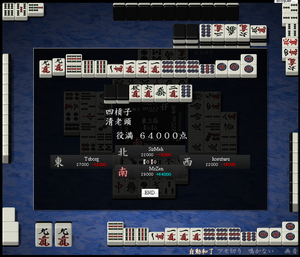Multiple yakuman

Multiple yakuman involve hands with more than one yakuman, as the name implies. While regular yaku may be stacked in one hand to raise value, the same can be done with different yakuman, where applicable.
In terms of scoring, the number of yakuman in the hand serves as a multiplier to the base yakuman point value. As a result, extremely high scoring hands are made possible.
If, in addition to one or more regular yakuman, the hand would also be a kazoe yakuman, no extra yakuman is added for this. For regular yakuman, han from normal yaku and dora are not counted.
Scoring
Application of the multiple yakuman may vary, as some rules do not allow multiple yakuman in terms of scoring. This is largely due to the extremely high value applied by multiple yakuman. In this case, even if the hand is composed of multiple yakuman, the score payout may be capped.
Single Yakuman Cap
Many professional organizations in Japan limit all payouts to a single yakuman, being 32,000 point for nondealer and 48,000 points for the dealer. This means that there are no double yakuman, and yakuman are not cumulative.
Cumulative Single Yakuman
Some groups, most notably Tenhou.net, do not award double yakuman for any specific hand, but will award double yakuman if two different yakuman are completed in the same hand---most commonly tsuu iisou alongside either shousuushi or daisangen.
Full Scoring
In many rulesets, not only are yakuman cumulative, but certain particularly rare and difficult hands are worth double the score value of a normal yakuman. For the most part, these are based on the wait patterns used to win the hand:
- daisuushi is more difficult to complete than the lesser hand shousuushi, which is still scored as yakuman. As a result, it is double yakuman.
- kokushi musou is double yakuman when completed on a 13-sided wait.
- chuuren poutou is double yakuman when completed on a 9-sided wait.
- suuankou is double yakuman when completed on a tanki wait. This is also the only way that the hand can win by ron.
EMA
The European Mahjong Association (EMA) has decided to apply a made-in-Europe variant of this rule, which specify that yakuman are not cumulative and double yakuman is not scored, with a single exception: a daisuushi hand is double yakuman.
Examples
* Single yakuman cap: 1 yakuman. (Note: 2 in the EMA) * Cumulative single yakuman: 1 yakuman. * Full scoring: 2 yakuman.
* Single yakuman cap: 1 yakuman. * Cumulative single yakuman: 2 yakuman. * Full scoring: 2 yakuman.
* Single yakuman cap: 1 yakuman. * Cumulative single yakuman: 2 yakuman. * Full scoring: 2 yakuman. Note: Winning this hand by ron will only be worth a single daisangen hand, under all circumstances.
* Single yakuman cap: 1 yakuman. * Cumulative single yakuman: 3 yakuman. * Full scoring: 4 yakuman.
Game examples
- 【麻雀】福光聖雄の小四喜・字一色!! (YouTube)
- Shousuushi + Tsuuiisou
| |||||||||||||||||||||||||||||||
